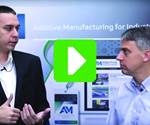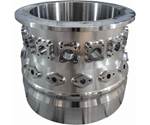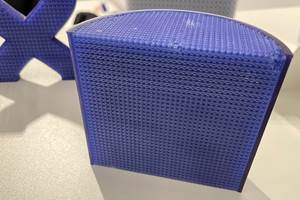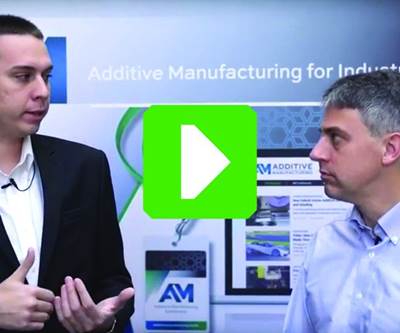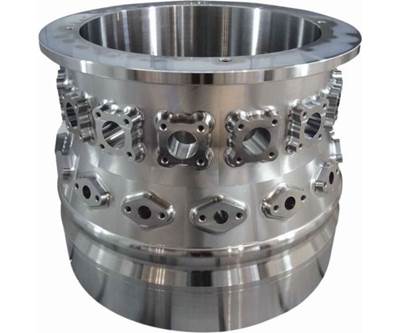Okuma Engineer Offers Safety Tips for Hybrid Machine Tools
Shop air should be out of reach, but flood coolant is a friend, he says. The real challenge of hybrid machines right now is not safety procedures but software.
Okuma America senior applications engineer Paul Kingsley says the safety considerations of a hybrid additive manufacturing machine are serious and represent an important factor in making use of this new type of machine tool. However, the safety considerations are manageable, and they are not proving to be the primary factor standing in the way of using a hybrid effectively.
The machine tool maker will formally debut its five-axis additive/subtractive machining center to the North American market this year at IMTS, though the machine already has sales in the western hemisphere following its earlier unveilings in Asia and Europe. Via laser metal deposition (LMD), the MU-8000V Laser EX multitasking machine can add metal to the workpiece for repair or to generate new features, with the added material and the underlying part then machined to tolerance as one in a subsequent step. Separate powder reservoirs even mean that multiple metals can be applied together in the same additive build, achieving material combinations that would not be practical in any other way. Kingsley says using the laser safely is a result of the design of the machine (it has reinforcement and sensors to preclude laser burn-through, for example), but safe use of the metal powder comes down to operator procedure.
Okuma shares a safety checklist for users of the hybrid machine. Considerations include ensuring working fire suppression; maintaining humidity matching the powder requirements; wearing a respirator with the ability to filter metal powder when directly handling this material; and cleaning with an “explosion-proof” vacuum featuring a self-contained motor. Kingsley offers some additional advice on safety, as follows:
- Prevent powder exposure. He reiterates: “When dealing with powder, you need to be wearing a good respirator mask.” This personal protective equipment is the most notable element of the new procedures that come with adopting powder metal AM. “In fact, I prefer to avoid physical contact of any kind,” he says. “I’ll wear latex gloves for any significant exposure, like cleaning the hopper.”
- Shop air should be out of reach. One common machine-shop practice needs to be off-limits. “You have to get used to not taking the air hose and blowing chips,” he says. Doing this with a hybrid could create a safety hazard. “What makes powder dangerous is the right mix with air,” he notes. It can ignite if it finds contact with the correct proportion of oxygen.
- Safeguard against sparks. “You also have to watch ignition sources and leads,” he says. The vacuum, for example, should be grounded to the machine. Anti-static floor mats are in order. “Think of the case of getting out of your car in the winter and making a spark,” he says. Simple opportunities for static discharge such as this need to be prevented.
- Keep the machine under control. “Our hybrid at Okuma is in a lab,” he notes. “I am not the only person who uses it, but I am always present when someone does.” This points to a valuable related procedure: Charge a safety champion with monitoring procedures for the additive machine.
- Coolant is a friend. “When we’re doing LMD, we’re also doing machining,” he says. Thanks to coolant, the latter assists with the safety of the former. It might seem that coolant and a laser-based process would not work well together, but the flood coolant in fact captures the metal powder into a slurry that significantly reduces the risk of airborne powder. The machine itself is protected against this slurry using the same features that would be found in a machine for milling graphite.
In the end, the safety procedures are straightforward. “Never be in a situation where you can breathe powder or ignite powder,” he says. Working within these procedures requires diligence, but it becomes second nature. Users of powder-based metal AM, hybrid or otherwise, have discovered this very thing. Safety is not the obstacle.
What is the greater challenge of making effective use of a hybrid machine today?
“Programming,” he says. CAM software has not been developed to serve additive capability on a machine tool anywhere near as effectively as it can program the other operations the machine performs.
Various software companies are working on this, he says. However, as yet, there are not enough hybrid machine users for this development to be a pressing concern. As a result, programming a cycle that includes building features at various angles and machining those same features from different directions generally requires splitting the cycle into several different programs that can all be defined more simply.
In short, with a hybrid, while any manufacturing team member can be expected to follow the safety procedures, not just anyone can write the tool paths. “This isn’t something you give your least experienced programmer,” Kingsley says. “You need someone who can manipulate the software and not just operate it,” because for the time being, some manual manipulation of the output of CAM is the way to obtain tool paths for additive operations.
Related Content
Copper, New Metal Printing Processes, Upgrades Based on Software and More from Formnext 2023: AM Radio #46
Formnext 2023 showed that additive manufacturing may be maturing, but it is certainly not stagnant. In this episode, we dive into observations around technology enhancements, new processes and materials, robots, sustainability and more trends from the show.
Read More7 Things We Saw at Formnext 2024 — Video Playlist
There were countless processes, applications and announcements at Formnext 2024. Here are seven standouts Peter Zelinski and Stephanie Hendrixson caught on film.
Read MoreOvercoming the Bottleneck to Customized Manufacturing: Quoting
Spokbee’s software-as-a-service platform is shaving months off of the quoting and pricing process for 3D printed and other types of configurable products.
Read MoreImplicit Modeling for Additive Manufacturing
Some software tools now use this modeling strategy as opposed to explicit methods of representing geometry. Here’s how it works, and why it matters for additive manufacturing.
Read MoreRead Next
Video: The Case for Hybrid Manufacturing in Moldmaking
Instead of relying on EDM to machine features recessed deep into the part, machine those features while 3D printing progresses, finishing them before they become hard to reach.
Read MoreHigh-Throughput Cell Segregates Additive, Subtractive Processes
The real value of building parts layer by layer isn't the potential to replace conventional, subractive machining, but to complement it.
Read MorePostprocessing Steps and Costs for Metal 3D Printing
When your metal part is done 3D printing, you just pull it out of the machine and start using it, right? Not exactly.
Read More

